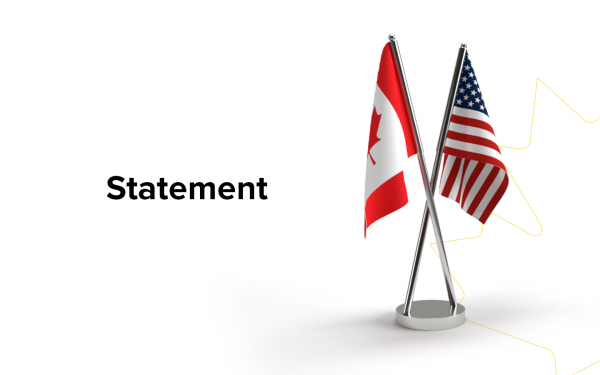Recommendations for Budget 2021
Dear Minister Freeland,
As I write to you, the second wave of COVID-19 infections in Canada is subsiding, new daily hospitalizations are falling, and the country’s vaccination campaign is ramping up. For the first time since the onset of the pandemic a year ago, Canadians have reason to hope that the worst of the health emergency is behind us.
On behalf of Canada’s business leaders, I want to thank you and your colleagues for your leadership at this difficult time. Public servants at all levels of government, and particularly health care workers, have worked hard to protect Canadians from the virus and respond to the economic fallout. The members of the Business Council of Canada join all Canadians in expressing gratitude for their service.
Many people have likened the fight against COVID-19 to a war. If, as now appears possible, we are finally gaining the upper hand, our country must prepare to confront another challenge familiar to the generation of Canadians that survived the Second World War: the task of rebuilding the economy, helping unemployed people find good jobs, and fostering a higher quality of life.
In Canada and elsewhere, the mantra for the post-COVID-19 recovery is “build back better”. This simple phrase means different things to different people. To some, it is a call to permanently expand the size and scope of government, the result of which would be larger deficits or higher taxes – or both. Rather than prioritizing economic growth and competitiveness, the government’s primary focus would be on wealth redistribution.
That approach, however, is clearly unsustainable. Without an enabling environment that prioritizes private-sector growth, nurtures new ventures, and incents existing businesses to invest and create well-paying jobs, the economy will falter and household incomes will stagnate. The inevitable result would be lower tax revenues to fund essential public services.
If we are serious about building back better, we must recognize that a stronger economy is fundamental to solving many of society’s most challenging issues – everything from high unemployment and inequality to the global fight against climate change. Economic growth leads to rising incomes and higher tax revenues, which in turn support high-quality public services. It fosters more and better jobs, expanding opportunities for people of all ages and abilities to achieve their full potential.
Fifteen months ago, our CEO Task Force on Canada’s Economic Future published a report outlining how governments, businesses and other stakeholders could work together to strengthen Canada’s growth capacity. The Task Force identified six priority actions that the federal government could take to improve the environment for private sector investment:
- Modernize the regulatory environment
- Prioritize nationally significant infrastructure projects
- Modernize and simplify the tax system
- Rethink Canadian foreign policy for a changing world
- Increase immigration inflows to build the future labour force Canada needs
- Develop a national resource and climate strategy
We believe that progress in each of these areas is essential to ensuring Canada’s long-term success in a rapidly changing global economy.
At the same time, we recognize that COVID-19 has created or exacerbated a range of additional economic and social challenges. For example:
- Just over a year ago, the country’s unemployment rate was 5.6 per cent – lower than at any point since the mid-1970s. Today it is 9.4 per cent, representing nearly 1.9 million jobless workers.
- Low-wage, immigrant and racialized workers have been disproportionately impacted by the pandemic, while Canadians with higher incomes and higher skill levels have largely been spared. Many recently displaced workers will need retraining to get back into the labour force.
- Many working parents, especially mothers, have faced an increased burden of family care responsibilities during the pandemic, leading some to cut their paid working hours or drop out of the labour force altogether. This has shone a light on the importance of quality, affordable child care in ensuring high rates of labour force participation among women.
- Lockdowns and work-from-home protocols have dramatically accelerated the rise of the digital economy and the shift to e-commerce. As the Canadian Council of Innovators has noted, the post-pandemic world will be significantly more data-driven than it was before COVID-19. To thrive in this new world, Canadians must become better at transforming knowledge and intellectual capital into commercial products and services.
- The pandemic ignited an explosion in public spending and debt. The federal debt-to-GDP ratio was 30 per cent before COVID-19 but now exceeds 50 per cent. This will impose serious constraints on the federal government’s fiscal capacity and further underscores the need for an economic growth strategy.
In recent months, our Council has reached out to a wide range of business and labour representatives, economists, non-profit groups and other organizations for their views on the best way to promote an inclusive post-pandemic economic recovery.
We also published a major paper, “Powering a Strong Recovery: An Economic Growth Plan for Canada”. Based on the work of our CEO Task Force as well as ongoing consultations with a diverse group of stakeholders, the paper acknowledged that there can be no quick fix to Canada’s economic malaise. Rather, building a more prosperous future for Canadians will require sustained action over many years on three fronts: people, capital and ideas.
People: We need to cultivate and enhance our human capital by developing a more agile and adaptable workforce, doing more to help young Canadians build rewarding careers, and enhancing our immigration system to make our country an even more powerful magnet for international talent.
Capital: We need to strengthen business investment by adopting a more focussed approach to infrastructure, enhancing interprovincial trade, removing unnecessary regulatory barriers, and ensuring that our tax system is globally competitive.
Ideas: In a world in which wealth creation is driven by knowledge and innovation, we must get better at commercializing our research, protecting intellectual property, harnessing the power of public procurement, and pursuing a more intentional industrial strategy that leverages Canada’s domestic strengths for success in the global market.
Over the following pages we will highlight several specific proposals for Budget 2021 within these three policy areas, as well as a number of recommendations that would put Canada on a path toward meeting its international commitments to reduce greenhouse gas (GHG) emissions.
People
The federal government should work with employers, provinces and territories to develop a comprehensive skills agenda that prepares displaced workers for new careers in sectors where talent is in high demand. One possible model is Palette, a national not-for-profit organization that helps young, fast-growing companies find the talent they need by rapidly re-skilling and up-skilling diverse and non-traditional workers. Training initiatives should be business-led and results-driven, similar to the approach taken by the Business + Higher Education Roundtable in expanding work-integrated learning opportunities for students and recent post-secondary graduates.
Equally important are investments to improve the quality, reliability, affordability and flexibility of early learning and child care services across the country. Such investments would enable more parents – especially women – to participate in the workforce, which in turn would strengthen gender equity, improve household finances, and support economic recovery. We welcome the federal government’s recent commitment to work with all provinces and territories to ensure that high-quality child care is accessible to all.
The federal government should prioritize initiatives and programs that facilitate the entry of skilled immigrants and remove barriers to their labour market integration. In both regulated and non-regulated occupations, foreign qualification recognition continues to pose a significant challenge for new Canadians.
Capital
As former Finance Minister John Manley has noted, business confidence is the single most powerful form of economic stimulus. The federal government can boost business confidence and encourage higher levels of private sector investment by committing to a responsible and prudent post-pandemic fiscal plan that avoids unnecessary new spending and seeks to gradually ease the burden of public debt. The government must adopt a clear fiscal anchor; we favour the proposal by David Dodge, former deputy minister of finance and governor of the Bank of Canada, to impose a limit of 10 per cent on the share of government revenue that is devoted to debt servicing. Furthermore, as the International Monetary Fund (IMF) said in its recent mission report on Canada, any new spending should be evaluated against broader policy objectives, including the need to increase the economy’s productive capacity.
Additional measures to spur business investment include:
- Reducing barriers to foreign direct investment. Canada currently ranks 17th in the OECD in openness to FDI.
- Extending the enhanced capital cost allowance rates that were introduced in the 2018 Fall Economic Statement.
- Resisting the temptation to raise corporate tax rates. If the Biden Administration moves forward with its proposal to increase the U.S. federal corporate income tax rate, Canada should take advantage of the opportunity to recover our country’s previous tax advantage over the United States.
- Further investing in trade-enhancing infrastructure, including by reinvesting in the National Trade Corridors Fund to improve access to foreign markets.
- Working with the provinces and territories with urgency to eliminate all remaining exemptions under the Canada Free Trade Agreement, a step the IMF says would add four per cent to the country’s GDP.
Kevin Lynch, former Clerk of the Privy Council, has for years called for a Canadian version of the Australian Productivity Commission, an independent agency that advises government on key policy or regulatory issues that affect Australia’s economic performance. Don Drummond, former chief economist at Toronto-Dominion Bank and a former associate deputy minister at the Department of Finance, more recently proposed the Canadian Equitable Growth Institute, a government agency that would focus on “strengthening economic growth in an environmentally sustainable manner with the benefits more evenly distributed among the population”.
In both cases, the goal is to ensure a deeper, broader and sustained focus on the importance of productivity and economic growth to national well-being. We are agnostic with regard to the specific approach but unequivocally endorse the objective. As we said in “Powering a Strong Recovery”, Canada’s productivity rates have lagged those of our peers for decades, resulting in lower incomes and lower household purchasing power. For the sake of future generations, we must be laser-focused on expanding our economic capacity.
Ideas
To create a more robust innovation ecosystem that contributes to growth, productivity and higher living standards, the federal government should embrace a demand-side, mission-driven approach to innovation policy, setting clear national goals to translate scientific strengths into economic performance. Specifically, we recommend that Canada create an agency similar to the U.S. Defense Advanced Research Projects Agency (DARPA). The agency should focus on high-growth sectors in which Canada has a competitive advantage – agri-food, health and biosciences, clean tech and energy, advanced manufacturing and digital services – using public-private partnerships to help scale-up and commercialize research.
In parallel with this effort, the federal government should take further steps to help Canadian researchers and entrepreneurs understand, protect, and capture value from their intellectual property (IP). As the Industry Strategy Council noted in its recent report, Canada currently ranks 17th on the World Intellectual Property Organization’s Global Innovation Index. For Canada to reap the benefits of its collective investments in innovation, we must become better at transforming knowledge and intellectual capital into commercial products and services. We need to adopt a Germany/Fraunhofer approach to R&D commercialization and IP protection.
Meeting the climate challenge
The federal government has tabled a comprehensive plan to meet or exceed its 2030 GHG-reduction target and has also committed to reach net-zero emissions by 2050. These are substantial commitments requiring a clear signal from the federal government that it is willing to partner with the private sector in facilitating the investments necessary to reduce emissions, enhance the competitiveness of Canada’s natural resource and manufacturing base, and create opportunities for Canadian clean technology innovators to grow their market share, both domestically and abroad. Early, strategic, and substantial investment is required to enable GHG-reduction technologies to move down the cost curve and to facilitate broad deployment at a scale necessary to meet the government’s 2030 and 2050 targets.
To enhance the private sector’s ability to invest in existing and emerging GHG-reduction opportunities – including carbon capture, utilization and sequestration (CCUS), hydrogen, renewable natural gas and other clean technologies – the Government of Canada should develop a policy framework that:
- Provides clarity and carbon policy and regulatory predictability to businesses that make long-term investments in the development and implementation of emissions-reduction technology;
- Creates stable revenue streams for companies and includes a broad suite of investment incentives benchmarked against internationally recognized best practices, such as production tax credits for CCUS (a potential model is the 45Q provisions in the United States), low-carbon fuel production and renewable power generation; accelerated capital cost allowances; access to a suite of verified carbon offsets; and flow-through shares;
- Clarifies the role of the federal government, both in strategic investments in R&D related to potential breakthrough technologies and in helping to de-risk private sector investment in emerging technologies, by providing significant and long-term funding support, including through the Canada Infrastructure Bank;
- Brings coherence and focus to federal funding that is designed to stimulate cleantech research and innovation. This includes funding from Sustainable Development Technology Canada, Business Development Canada and Export Development Canada;
- Supports Indigenous peoples, communities and organizations that want to participate in the energy transition, through ownership and equity, jobs, procurements, skills and training, and community investment.
- Streamlines the approval and permitting processes necessary to support major GHG emissions-reduction projects.
In closing, Minister, let me again thank you and your colleagues for your efforts to guide Canada through and beyond the current health emergency. You recently stated that the 2021 budget will be among the most significant of our lifetimes. For the economic recovery from COVID-19 to be durable and resilient, the budget must establish a responsible and credible fiscal framework. It must foster a partnership between government and the private sector to boost investment and job creation. It must enhance productivity growth and strengthen the ability of Canadians and Canadian companies to compete and win in the global economy.
The members of the Business Council of Canada stand ready to work with you and all parliamentarians in forging a better, stronger, more productive economy that benefits all Canadians.
Sincerely,

Goldy Hyder
President and CEO
Business Council of Canada











